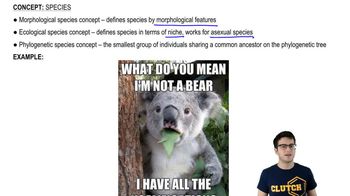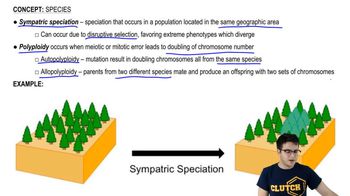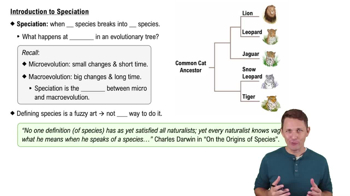Table of contents
- 1. Introduction to Biology2h 42m
- 2. Chemistry3h 40m
- 3. Water1h 26m
- 4. Biomolecules2h 23m
- 5. Cell Components2h 26m
- 6. The Membrane2h 31m
- 7. Energy and Metabolism2h 0m
- 8. Respiration2h 40m
- 9. Photosynthesis2h 49m
- 10. Cell Signaling59m
- 11. Cell Division2h 47m
- 12. Meiosis2h 0m
- 13. Mendelian Genetics4h 44m
- Introduction to Mendel's Experiments7m
- Genotype vs. Phenotype17m
- Punnett Squares13m
- Mendel's Experiments26m
- Mendel's Laws18m
- Monohybrid Crosses19m
- Test Crosses14m
- Dihybrid Crosses20m
- Punnett Square Probability26m
- Incomplete Dominance vs. Codominance20m
- Epistasis7m
- Non-Mendelian Genetics12m
- Pedigrees6m
- Autosomal Inheritance21m
- Sex-Linked Inheritance43m
- X-Inactivation9m
- 14. DNA Synthesis2h 27m
- 15. Gene Expression3h 20m
- 16. Regulation of Expression3h 31m
- Introduction to Regulation of Gene Expression13m
- Prokaryotic Gene Regulation via Operons27m
- The Lac Operon21m
- Glucose's Impact on Lac Operon25m
- The Trp Operon20m
- Review of the Lac Operon & Trp Operon11m
- Introduction to Eukaryotic Gene Regulation9m
- Eukaryotic Chromatin Modifications16m
- Eukaryotic Transcriptional Control22m
- Eukaryotic Post-Transcriptional Regulation28m
- Eukaryotic Post-Translational Regulation13m
- 17. Viruses37m
- 18. Biotechnology2h 58m
- 19. Genomics17m
- 20. Development1h 5m
- 21. Evolution3h 1m
- 22. Evolution of Populations3h 52m
- 23. Speciation1h 37m
- 24. History of Life on Earth2h 6m
- 25. Phylogeny2h 31m
- 26. Prokaryotes4h 59m
- 27. Protists1h 12m
- 28. Plants1h 22m
- 29. Fungi36m
- 30. Overview of Animals34m
- 31. Invertebrates1h 2m
- 32. Vertebrates50m
- 33. Plant Anatomy1h 3m
- 34. Vascular Plant Transport1h 2m
- 35. Soil37m
- 36. Plant Reproduction47m
- 37. Plant Sensation and Response1h 9m
- 38. Animal Form and Function1h 19m
- 39. Digestive System1h 10m
- 40. Circulatory System1h 57m
- 41. Immune System1h 12m
- 42. Osmoregulation and Excretion50m
- 43. Endocrine System1h 4m
- 44. Animal Reproduction1h 2m
- 45. Nervous System1h 55m
- 46. Sensory Systems46m
- 47. Muscle Systems23m
- 48. Ecology3h 11m
- Introduction to Ecology20m
- Biogeography14m
- Earth's Climate Patterns50m
- Introduction to Terrestrial Biomes10m
- Terrestrial Biomes: Near Equator13m
- Terrestrial Biomes: Temperate Regions10m
- Terrestrial Biomes: Northern Regions15m
- Introduction to Aquatic Biomes27m
- Freshwater Aquatic Biomes14m
- Marine Aquatic Biomes13m
- 49. Animal Behavior28m
- 50. Population Ecology3h 41m
- Introduction to Population Ecology28m
- Population Sampling Methods23m
- Life History12m
- Population Demography17m
- Factors Limiting Population Growth14m
- Introduction to Population Growth Models22m
- Linear Population Growth6m
- Exponential Population Growth29m
- Logistic Population Growth32m
- r/K Selection10m
- The Human Population22m
- 51. Community Ecology2h 46m
- Introduction to Community Ecology2m
- Introduction to Community Interactions9m
- Community Interactions: Competition (-/-)38m
- Community Interactions: Exploitation (+/-)23m
- Community Interactions: Mutualism (+/+) & Commensalism (+/0)9m
- Community Structure35m
- Community Dynamics26m
- Geographic Impact on Communities21m
- 52. Ecosystems2h 36m
- 53. Conservation Biology24m
23. Speciation
Introduction to Speciation
Problem 15`
Textbook Question
In a follow-up study in 2020, Joshua Akey and colleagues discovered that the genomes of modern Africans contain a small amount of Neanderthal DNA due to migration of some Europeans back to Africa after interbreeding with Neanderthals. Given the large amount of variation within human populations, how would you know whether there is a significant difference in percentage of Neanderthal DNA between modern Europeans and modern Africans?
 Verified step by step guidance
Verified step by step guidance1
Formulate a hypothesis: Determine if there is a significant difference in the percentage of Neanderthal genes between students with blue eyes and those with brown eyes. The null hypothesis (H0) could be that there is no difference, while the alternative hypothesis (H1) could be that there is a difference.
Collect data: Sequence the DNA of students with blue eyes and those with brown eyes to determine the percentage of Neanderthal genes in each individual's genome.
Organize the data: Group the data into two categories based on eye color (blue and brown) and calculate the mean percentage of Neanderthal genes for each group.
Perform a statistical test: Use an appropriate statistical test, such as a t-test, to compare the means of the two groups. This will help determine if any observed difference is statistically significant.
Interpret the results: Analyze the p-value obtained from the statistical test. If the p-value is less than the chosen significance level (commonly 0.05), reject the null hypothesis and conclude that there is a significant difference in the percentage of Neanderthal genes between the two groups.
 Verified video answer for a similar problem:
Verified video answer for a similar problem:This video solution was recommended by our tutors as helpful for the problem above
Video duration:
3mPlay a video:
Was this helpful?
Key Concepts
Here are the essential concepts you must grasp in order to answer the question correctly.
Neanderthal DNA in Modern Humans
Neanderthal DNA refers to the genetic material inherited from Neanderthals, an extinct species closely related to modern humans. After interbreeding events between Neanderthals and early Homo sapiens, some Neanderthal genes were integrated into the human genome. Today, non-African populations typically have about 1-4% Neanderthal DNA, which can influence various traits and susceptibilities.
Recommended video:
Guided course

The Human Population
Genetic Variation and Eye Color
Eye color is a polygenic trait primarily determined by the interaction of multiple genes, with the OCA2 and HERC2 genes playing significant roles. Variations in these genes can lead to different eye colors, such as blue or brown. Understanding genetic variation is crucial for studying how certain traits, like eye color, might correlate with other genetic factors, such as Neanderthal DNA.
Recommended video:

Sources of Genetic Variation
Statistical Significance in Genetic Studies
Statistical significance is a measure used to determine if the observed differences in data are likely due to chance or represent a true effect. In genetic studies, statistical tests, such as t-tests or ANOVA, can be used to compare the percentage of Neanderthal DNA between groups (e.g., blue-eyed vs. brown-eyed students) to assess if any observed differences are significant, considering sample size and variability.
Recommended video:
Guided course

Levels of Ecological Study

 3:03m
3:03mWatch next
Master Introduction to Speciation with a bite sized video explanation from Jason
Start learningRelated Videos
Related Practice


















